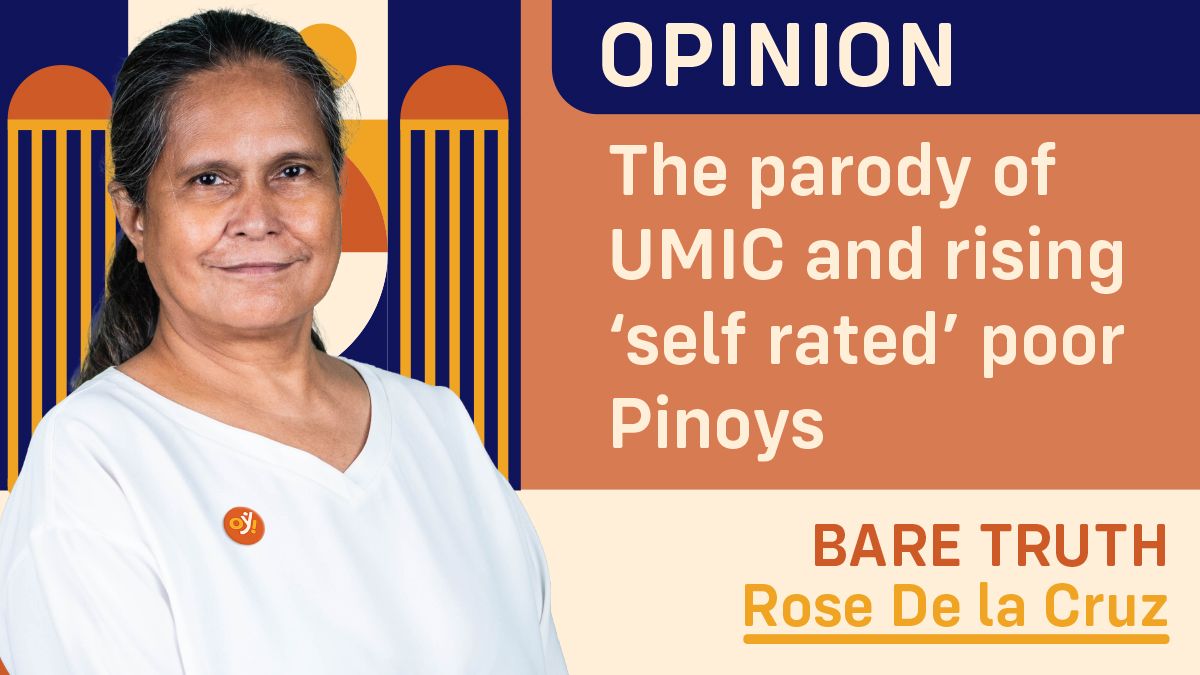This administration is so obsessed with achieving an upper middle income status for the Philippines, which President Marcos claims to be achieved this year.
But a reality check would show that 63 percent of Filipino families rated themselves “poor” in December 2024, worse than its level in November 2003 (record level of self-rated poverty) of 64 percent, based on the Social Weather Survey report last January 8.
In other words, we would be presenting a bipolar image of the Philippines– one that claims to achieve UMIC status this year amidst its yawning self rated poverty.
We have long stayed at the lower middle- income status as a nation with a gross national income per capita between $1,136 and $4,465 while our aspiration for UMIC economy– meaning our GNI per capita is between $4,466 and $13,845 and above– is hardly visible for the majority strugglers or the middle class and more so for the lower class people.
Marcos made his boast during the Vin D’Honneur, where he hosted members of the diplomatic corps in Malacañang on Saturday saying “we are confident that the country will be able to hit this year the GNI [gross national income] per capita range set by the World Bank to reach upper middle-income country [UMIC] status, coming off from an all-time-high record registered in 2023 to the tune of USD4,335.
The economic growth this year will be attracting more foreign investments by accelerating infrastructure investments, enhancing the ease of doing business, and boosting national competitiveness.
The government was initially targeting to achieve upper-middle income status in 2020, but the Philippine economy contracted from the strict quarantine measures during the pandemic.
Marcos said the projects will be funded through an increase in government revenue collection, which reached P4.42 trillion last year—the highest in the last 27 years—and through prudent and transparent debt management.
Marcos also reiterated his call for support for the country’s bid to obtain a non-permanent seat in the United Nations Security Council (UNSC) for the term of 2027-2028 and strengthening diplomatic ties with the opening of four more Foreign Service Posts in North America, Asia and the Pacific bringing the total posts to 102 by end of 2025.
The SWS said the ranks of self rated poor families swelled to 63 percent, or four-point increase from 59 percent in September 2024, with an estimated 17.4 million families claiming to have slid to this stature from high costs of living, principally food, transport and utilities and rising unemployment and underemployment levels.
SWS data also showed a rise in self- rated poverty for the third consecutive quarter last year, following a 12-point jump from March to June 2024. The annual average for 2024 was 57 percent, nine points higher than the 48 percent recorded in 2023 and 2022.
Borderline families, who consider themselves between poor and not poor, dropped to 11 percent, a slight decrease from 13 percent in September and 12 percent in June 2024, following a sharp decline from 30 percent in March.
Only 26 percent of families did not consider themselves poor, down from 28 percent in September and 30 percent in June.
As always, self rated poverty was highest in Mindanao at 76 percent, followed by the Visayas at 74 percent, Balance Luzon at 55 percent, and Metro Manila at 51 percent.
Food poverty
The uncontrollable rise in food prices and costs of transportation, rental and public utilities, have brought upticks in inflation.
Food poverty was experienced by, 51 percent of families who saw themselves food-poor, 13 percent as food-borderline, and 36 percent as not food-poor.
The 51-percent mark was the highest in over 20 years and a five-point increase from 46 percent in September.
The survey also found that 10.2 percent of families who considered themselves poor were non-poor one to four years ago, while 7.6 percent were non-poor five or more years ago. About 44.7 percent, however, have never experienced being non-poor.
The median monthly family expenses were P3,000 for house rent, P2,000 for transportation, P1,000 for internet, and P300 for mobile phone load.
The survey was conducted from December 12 to 18 with 2,160 adults nationwide, using face-to-face interviews, and had sampling error margins of ±2 percent nationally, ±3 percent in Balance Luzon, and ±5 percent in Metro Manila, the Visayas and Mindanao.
So much for bragging!
#WeTakeAStand #OpinYon #OpinYonNews #OpinYonColumn #BareTruth
